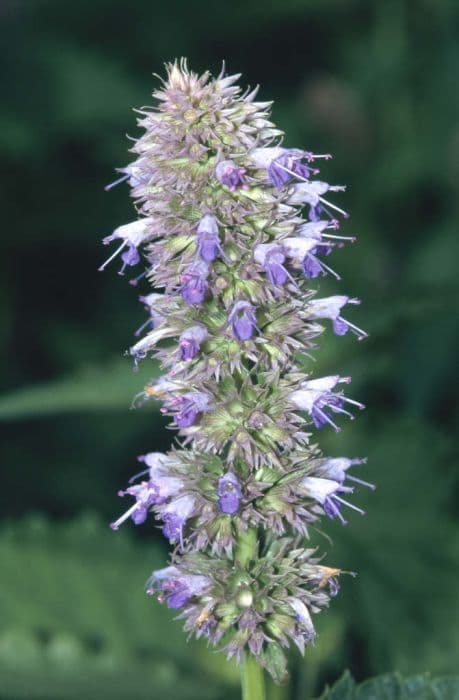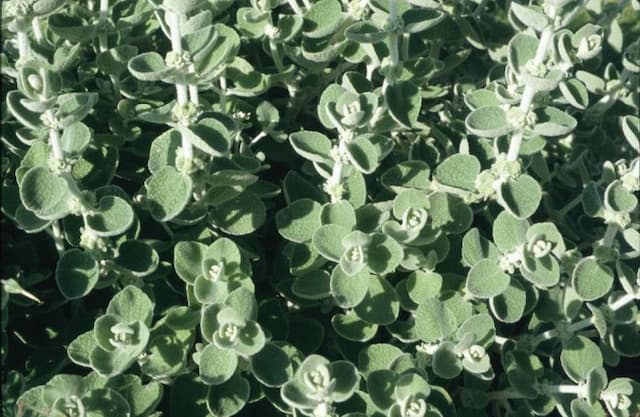Cherry Red Sage Salvia Mirage Cherry Red = 'Balmircher' (PBR) (Mirage Series)

ABOUT
Salvia Mirage Cherry Red 'Balmircher' (PBR) from the Mirage Series is a vibrant perennial known for its striking red flowers. The plant produces dense, vertical spikes adorned with deep cherry-red blossoms that boast a tubular shape, attracting hummingbirds and butterflies. The flowers cluster tightly together, creating a bold and colorful display throughout its blooming period. The foliage of this Salvia is equally attractive, with textured leaves that are often aromatic when crushed or brushed against, adding to the sensory experience of the plant. These leaves are typically a rich green color, which serves as a perfect backdrop that highlights the intensity of the red flowers. The overall appearance of the Salvia Mirage Cherry Red is one of lushness and a profusion of vivid blooms that stand out in any garden setting, providing a long-lasting pop of color and making it a favorite among gardeners looking to create eye-catching borders or flowerbeds.
About this plant
 Names
NamesFamily
Lamiaceae
Synonyms
Cherry Red Autumn Sage, Mirage Cherry Red Sage
Common names
Salvia 'Balmircher'
 Toxicity
ToxicityTo humans
The Salvia, commonly known as sage, is generally not toxic to humans. In the case of the Mirage Cherry Red, there is no specific evidence to suggest that this cultivar is toxic when touched or ingested in small quantities. However, as with many plants, individual allergies or sensitivities could occur. Eating Salvia in large amounts could potentially cause stomach upset or other digestive disturbances due to the presence of various compounds in the plant. It is advised to avoid ingesting this plant in large quantities, and children should be taught not to eat any part of ornamental plants due to the risk of choking or potential toxicity from other plants.
To pets
The Salvia, commonly known as sage, is not typically toxic to pets. The Mirage Cherry Red variety has no specific toxic properties reported for animals either. Pets that ingest small amounts of Salvia may experience mild gastrointestinal upset, but significant toxicity is rare. However, some pets could be more sensitive to plants than others, and it is always wise to prevent them from consuming ornamental plants. If large amounts are ingested, or if your pet shows signs of distress after eating Salvia, it is prudent to consult a veterinarian.
 Characteristics
CharacteristicsLife cycle
Perennials
Foliage type
Deciduous
Color of leaves
Green
Flower color
Red
Height
18 inches (45 cm)
Spread
24 inches (60 cm)
Plant type
Herb
Hardiness zones
5
Native area
Cultivar
Benefits
 General Benefits
General Benefits- Attractive Blooms: Features vibrant cherry red flowers that can brighten up any garden space.
- Long Flowering Period: It has a long bloom time from late spring to fall, providing extended visual interest.
- Drought Tolerance: Once established, it has good drought resistance, making it suitable for dry climates and water-wise gardens.
- Low Maintenance: Requires minimal care once established, making it ideal for gardeners of all skill levels.
- Attracts Pollinators: Draws in beneficial insects like bees and butterflies, which are essential for pollination.
- Compact Size: Its size makes it suitable for small gardens, containers, or borders without overwhelming the space.
- Deer Resistance: Generally resistant to deer, which can help prevent damage to the garden from wildlife.
 Medical Properties
Medical PropertiesThis plant is not used for medical purposes.
 Air-purifying Qualities
Air-purifying QualitiesThis plant is not specifically known for air purifying qualities.
 Other Uses
Other Uses- As a natural fabric dye: The bright red flowers of Cherry Red Sage can be used to dye fabrics, providing a source of natural color for textile enthusiasts.
- In sachets and potpourris: Dried Cherry Red Sage flowers can be added to sachets and potpourris for a pleasant aroma and to add a splash of color to the mixture.
- As a natural ink or paint: The pigments from Cherry Red Sage flowers can be used to make natural inks or paints for art projects, offering a sustainable alternative to synthetic products.
- Plant photography subject: The striking red blossoms make Cherry Red Sage a popular choice for garden photographers and plant enthusiasts, capturing its vivid hues in various lighting conditions.
- Garden mulch: After the blooming season, the spent flowers and leaves of Cherry Red Sage can be chopped up and used as an organic mulch, contributing to the soil's nutrient content.
- In crafts and flower arrangements: Fresh or dried Cherry Red Sage can be used in decorative crafts and floral arrangements, adding both color and a subtle fragrance to the creations.
- Educational tool for botany studies: Cherry Red Sage can serve as an excellent specimen for teaching botany, especially topics related to pollination and flowering plant life cycles.
- As part of a color-themed garden design: Incorporating Cherry Red Sage into gardens designed with color themes, the plant's vivid red blooms can help create a stunning visual impact.
- Culinary decoration: While not commonly eaten, the non-toxic flowers of Cherry Red Sage can be used as an edible garnish to brighten up dishes and desserts.
- Wildlife habitat enhancement: Planting Cherry Red Sage in the garden can attract pollinators such as bees and butterflies, thus supporting local biodiversity.
Interesting Facts
 Feng Shui
Feng ShuiThe plant Salvia is not used in Feng Shui practice.
 Zodiac Sign Compitability
Zodiac Sign CompitabilityThe plant Salvia is not used in astrology practice.
 Plant Symbolism
Plant Symbolism- Sage Wisdom: As a member of the Salvia genus, this plant is often associated with wisdom and long life. As sage has been used for centuries in both culinary and ritual contexts, it carries a reputation for insight and intelligence.
- Immortality: The enduring nature of perennial Salvias, including the Mirage Series, symbolizes longevity and the enduring cycle of life and death.
- Healing: Historically, many Salvia species were used for medicinal purposes, which is why they're often thought to represent health and healing.
- Protection: In folklore, Salvias, including the Mirage Cherry Red, were sometimes planted in gardens to protect against evil spirits and bad luck.
- Passion: The intense red color of the 'Balmircher' blooms can symbolize passion, love, and vitality, making it a fitting addition to romantic or emotionally meaningful settings.
 Water
WaterCherry Red Autumn Sage should be watered deeply and infrequently to encourage a strong root system. This typically translates to about 1 inch of water per week, but this can vary based on temperature and soil conditions. During hot, dry spells, water the plant more frequently—about twice a week—but always check the soil moisture first; it should be allowed to dry out slightly between waterings. Avoid overhead watering to keep the foliage dry and prevent fungal diseases. When watering, aim to provide approximately half a gallon of water to the base of the plant, ensuring even soil moisture distribution.
 Light
LightCherry Red Autumn Sage thrives in full sunlight, so it should be planted in a spot where it receives at least 6 to 8 hours of direct sunlight each day. The more sun it gets, the more vibrant the flowering will be. Partial shade is tolerable, especially in regions with very intense summer sun, but too much shade will diminish blooming and can cause the plant to become leggy.
 Temperature
TemperatureCherry Red Autumn Sage prefers warm temperatures and is hardy in USDA zones 7 to 9. It can survive minimum temperatures down to 10 degrees Fahrenheit, but the ideal temperature range for vigorous growth is between 60 to 85 degrees Fahrenheit. This plant tolerates heat well, but it is not frost-tolerant and should be protected if temperatures consistently fall below the minimum threshold.
 Pruning
PruningPruning Cherry Red Autumn Sage is important to promote bushy growth and abundant flowering. Prune in late winter or early spring, just before new growth begins, cutting back the plant by about one-third to one-half. This helps to remove any dead or woody stems and encourages fresh growth. Additionally, deadheading or removing spent flowers during the growing season can encourage reblooming. Prune lightly again after the last flowers fade to tidy the plant’s appearance.
 Cleaning
CleaningAs needed
 Soil
SoilCherry Red Autumn Sage prefers well-draining soil enriched with compost. A mix of two parts garden soil, one part compost, and one part perlite or coarse sand is ideal. The soil pH should be slightly acidic to neutral, around 6.0 to 7.0, for optimal growth.
 Repotting
RepottingCherry Red Autumn Sage should be repotted every 1-2 years to replenish the soil and accommodate root growth. Spring is the best time to repot, just before the new growth starts.
 Humidity & Misting
Humidity & MistingCherry Red Autumn Sage thrives in moderate humidity levels. It does not require high humidity and is fairly adaptable to typical outdoor humidity conditions.
 Suitable locations
Suitable locationsIndoor
Place in bright light and allow soil to dry between waterings.
Outdoor
Plant in full sun, well-draining soil, and water regularly.
Hardiness zone
7-10 USDA
 Life cycle
Life cycleThe Salvia Mirage Cherry Red, commonly known as Cherry Red Sage, begins its life cycle as a seed which, when provided with the right conditions of warmth and moisture, germinates to produce small seedlings. The seedlings then develop a root system and foliage as they grow, entering the vegetative stage where they increase in size and mass. Upon reaching maturity, Cherry Red Sage begins the flowering stage, producing vibrant red flowers that attract pollinators and are characteristic of the Mirage Series. After pollination, the flowers produce seeds, completing the reproductive stage. Once the seeds are dispersed, the parent plant either continues to grow and produce flowers cyclically (if it is a perennial) or it may die back if it is grown as an annual, depending on the climate and growing conditions. The cycle is then ready to start again with the new seeds germinating into the next generation of plants.
 Propogation
PropogationPropogation time
Early Spring
The most popular method of propagation for the Salvia Mirage Cherry Red is by taking stem cuttings. This is typically done in late spring when the plant's growth is most vigorous. A healthy, non-flowering shoot is chosen and a cutting approximately 3-4 inches (about 7.6-10.2 cm) long is snipped just below a node. The bottom leaves are removed, and the cut end is dipped in rooting hormone to encourage root growth. The cutting is then placed in a moist potting mix, ensuring that at least one node is below the surface. The pot should be kept in a warm location with indirect sunlight and consistently moist soil until the cutting has rooted, which can take a few weeks. Once roots have established, the new Salvia plant can be transplanted to its permanent location.









